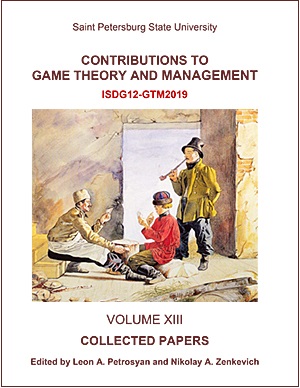Mechanism for Shifting Nash Equilibrium Trajectories to Cooperative Pareto Solutions in Dynamic Bimatrix Games
DOI:
https://doi.org/10.21638/11701/spbu31.2020.12Abstract
In the paper, constructions of the generalized method of characteristics are applied for calculating the generalized minimax (viscosity) solutions of Hamilton-Jacobi equations in dynamic bimatrix games. The structure of the game presumes interactions of two players in the framework of the evolutionary game model. Stochastic contacts between players occur according to the dynamic process, which can be interpreted as a system of Kolmogorov's differential equations with controls instead of probability parameters. It is assumed that control parameters are not fixed and can be constructed by the feedback principle. Two types of payoff functions are considered: short-term payoffs are determined in the current moments of time, and long-term payoffs are determined as limit functionals on the infinite time horizon. The notion of dynamic Nash equilibrium in the class of controlled feedbacks is considered for the long-term payoffs. In the framework of constructions of dynamic equilibrium, the solutions are designed on the basis of maximization of guaranteed payoffs. Such guaranteeing strategies are built in the framework of the theory of minimax (viscosity) solutions of Hamilton-Jacobi equations. The analytical formulas are obtained for the value functions in the cases of different orientations for the “zigzags” (broken lines) of acceptable situations in the static game. The equilibrium trajectories generated by the minimax solutions shift the system in the direction of cooperative Pareto points. The proposed approach provides new qualitative properties of the equilibrium trajectories in the dynamic bimatrix games which guarantee better results of payoffs for both players than static Nash equilibria. As an example, interactions of two firms on the market of innovative electronic devices are examined within the proposed approach for treating dynamic bimatrix games.
Keywords:
optimal control, dynamic bimatrix games, value functions, minimax solutions of Hamilton-Jacobi equations, dynamic Nash equilibrium trajectories, shift to Pareto maximum
Downloads
References
Downloads
Published
How to Cite
Issue
Section
License
Articles of "Contributions to Game Theory and Management" are open access distributed under the terms of the License Agreement with Saint Petersburg State University, which permits to the authors unrestricted distribution and self-archiving free of charge.




